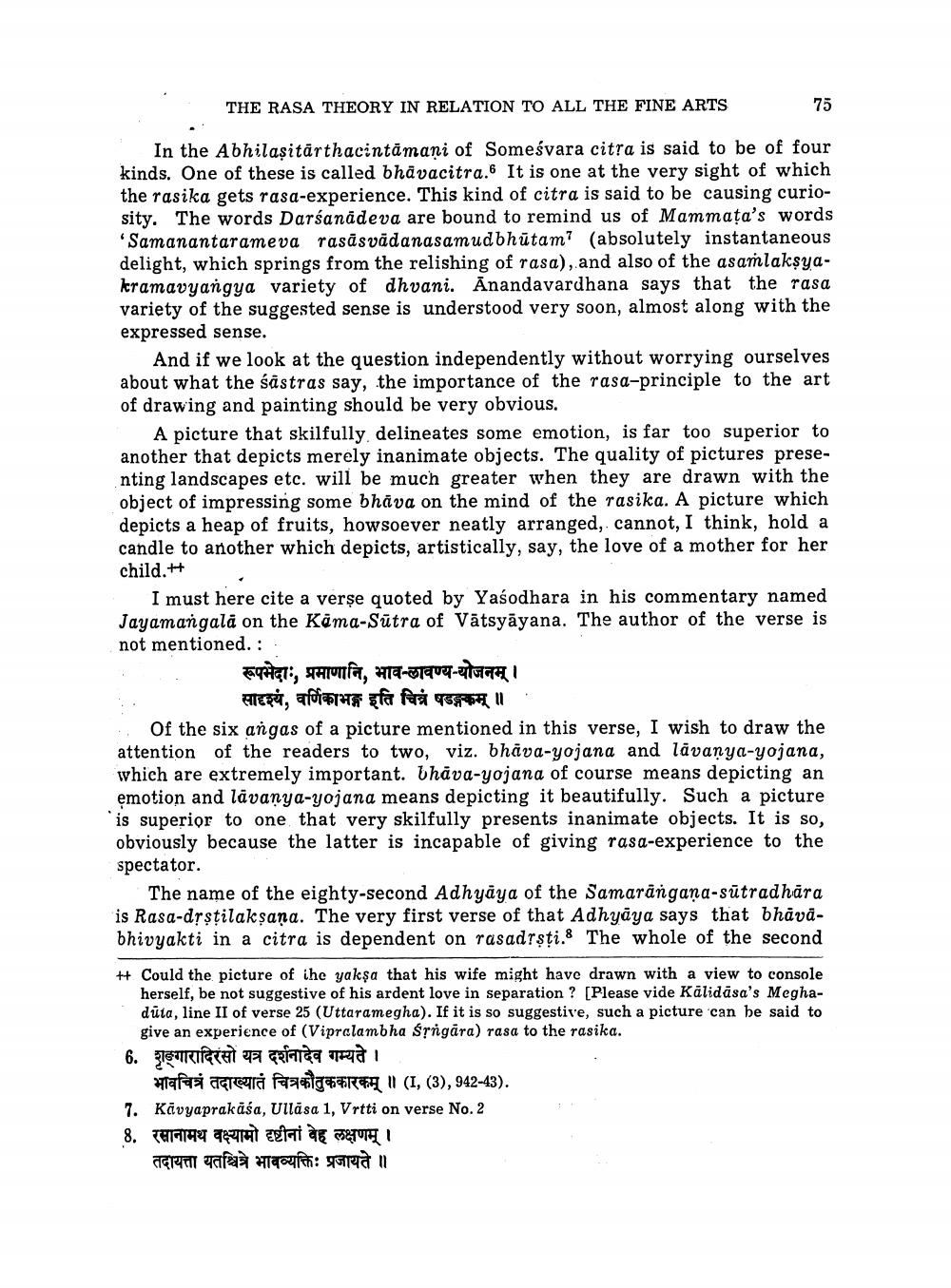________________
THE RASA THEORY IN RELATION TO ALL THE FINE ARTS
75
In the Abhilaşitärthacintamani of Someśvara citra is said to be of four kinds. One of these is called bhävacitra. It is one at the very sight of which the rasika gets rasa-experience. This kind of citra is said to be causing curiosity. The words Darsanādeva are bound to remind us of Mammața's words 'Samanantarameva rasāsvādanasamudbhūtam? (absolutely instantaneous delight, which springs from the relishing of rasa), and also of the asamlakşyakeramavyangya variety of dhvani. Anandavardhana says that the rasa variety of the suggested sense is understood very soon, almost along with the expressed sense.
And if we look at the question independently without worrying ourselves about what the sastras say, the importance of the rasa-principle to the art of drawing and painting should be very obvious.
A picture that skilfully, delineates some emotion, is far too superior to another that depicts merely inanimate objects. The quality of pictures presenting landscapes etc. will be much greater when they are drawn with the object of impressing some bhäva on the mind of the rasika. A picture which depicts a heap of fruits, howsoever neatly arranged, cannot, I think, hold a candle to another which depicts, artistically, say, the love of a mother for her
child.++
I must here cite a verse quoted by Yasodhara in his commentary named Jayamangalä on the Kama Sutra of Vātsyāyana. The author of the verse is not mentioned. ::
रूपभेदाः, प्रमाणानि, भाव-लावण्य-योजनम् ।
सादृश्य, वर्णिकाभङ्ग इति चित्रं षडङ्गकम् ॥ . :: Of the six angas of a picture mentioned in this verse, I wish to draw the attention of the readers to two, viz. bhava-yojana and lavanya-yojana, which are extremely important. Whāva-yojana of course means depicting an emotion and lāvanya-yojana means depicting it beautifully. Such a picture is superior to one that very skilfully presents inanimate objects. It is so, obviously because the latter is incapable of giving rasa-experience to the spectator.
The name of the eighty-second Adhyāya of the Samarāngana-sūtradhāra is Rasa-drsţilaksana. The very first verse of that Adhyāya says that bhavabhivyakti in a citra is dependent on rasadrsti.8 The whole of the second
+ Could the picture of the yakşa that his wife might have drawn with a view to console
herself, be not suggestive of his ardent love in separation ? [Please vide Kalidasa's Meghadüta, line II of verse 25 (Uttaramegha). If it is so suggestive, such a picture can be said to
give an experience of (Vipralambha śrrgåra) rasa to the rasika. 6. 316TTITAT 7 Etaga trai
afasi agreari faalg #R44 II (I, (3), 942-43). 7. Kavyaprakāśa, Ullása 1, Vrtti on verse No. 2 8. रसानामथ वक्ष्यामो दृष्टीनां वेह लक्षणम् ।
तदायत्ता यतश्चित्रे भावव्यक्तिः प्रजायते ॥




